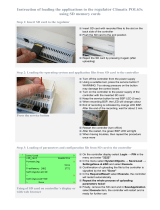
vi
Chapter 3: Customizing the BSP
for Application Hardware ................................................................................ 1
7
Overview ...................................................................................................................... 18
Before you begin.......................................................................................................... 18
Task 1: Purchase Ethernet MAC addresses from the IEEE ................................... 19
Task 2: Create a new platform directory ................................................................. 20
Task 3: Modify the BSP configuration settings ....................................................... 20
Task 4: Modify the BSP makefile .............................................................................. 21
Task 5: Modify the linker scripts............................................................................... 21
Bootloader considerations ............................................................................... 22
Task 6: Modify the new BSP to support your application hardware .................. 22
Phase Lock Loop ............................................................................................... 23
Memory timing settings................................................................................... 23
Chip select settings ........................................................................................... 24
General purpose I/O settings ......................................................................... 25
Ethernet PHY..................................................................................................... 28
Simple serial driver........................................................................................... 28
Task 7: Modify the format of BSP arguments in NVRAM.................................... 28
Task 8: Modify error and exception handlers......................................................... 29
Task 9: Create the debugger initialization files....................................................... 30
Task 10: Debug the initialization code ..................................................................... 32
Working with a locked-up ICE ....................................................................... 32
Preparing to debug ........................................................................................... 33
Debugging the initialization code .................................................................. 34
Task 11: Modify the Startup dialog .......................................................................... 37
Task 12: Modify the POST ......................................................................................... 37
Task 13: Modify the ACE ........................................................................................... 37
Chapter 4:
Device Drivers............................................................................. 39
Overview ...................................................................................................................... 40
Adding devices............................................................................................................ 40
deviceInfo structure.................................................................................................... 40
Device driver functions.............................................................................................. 42






















